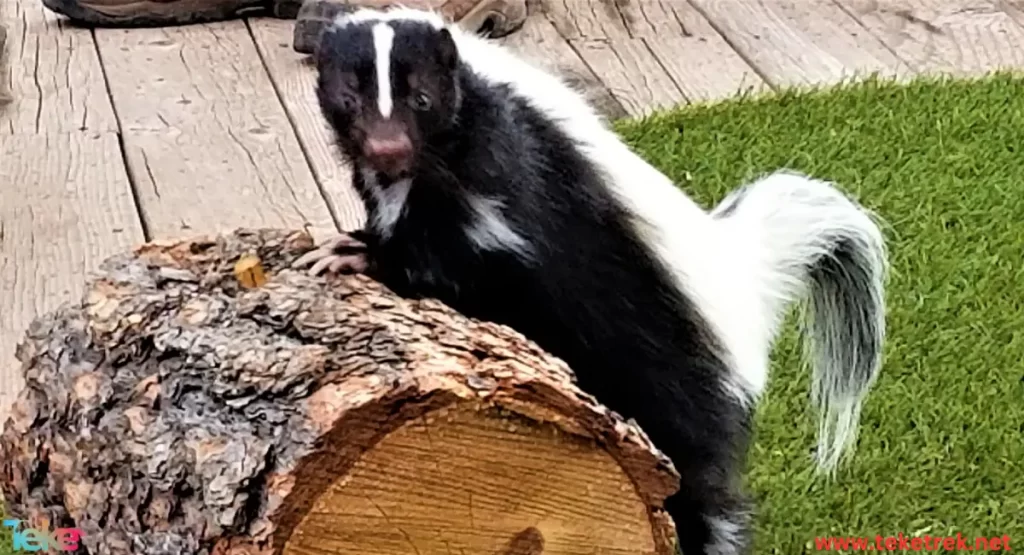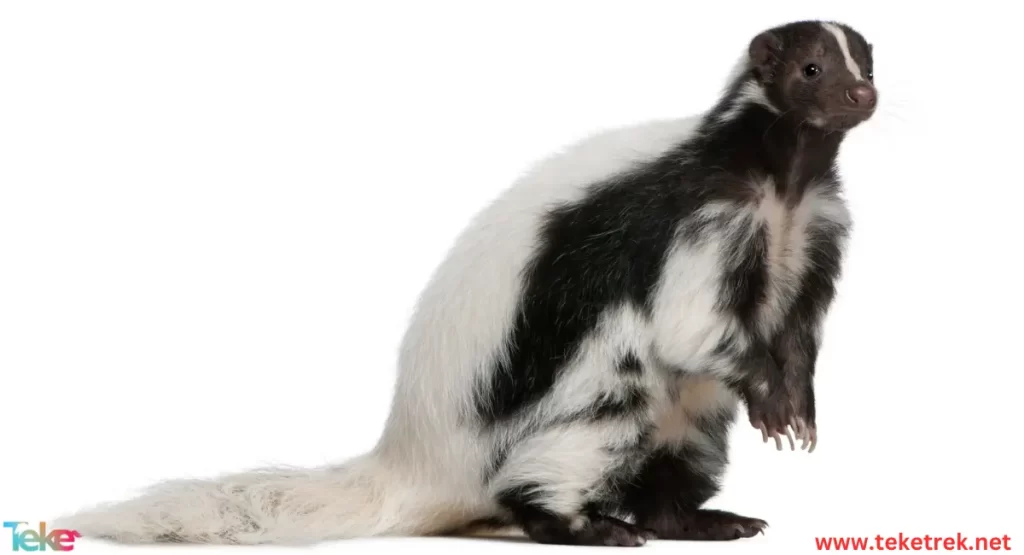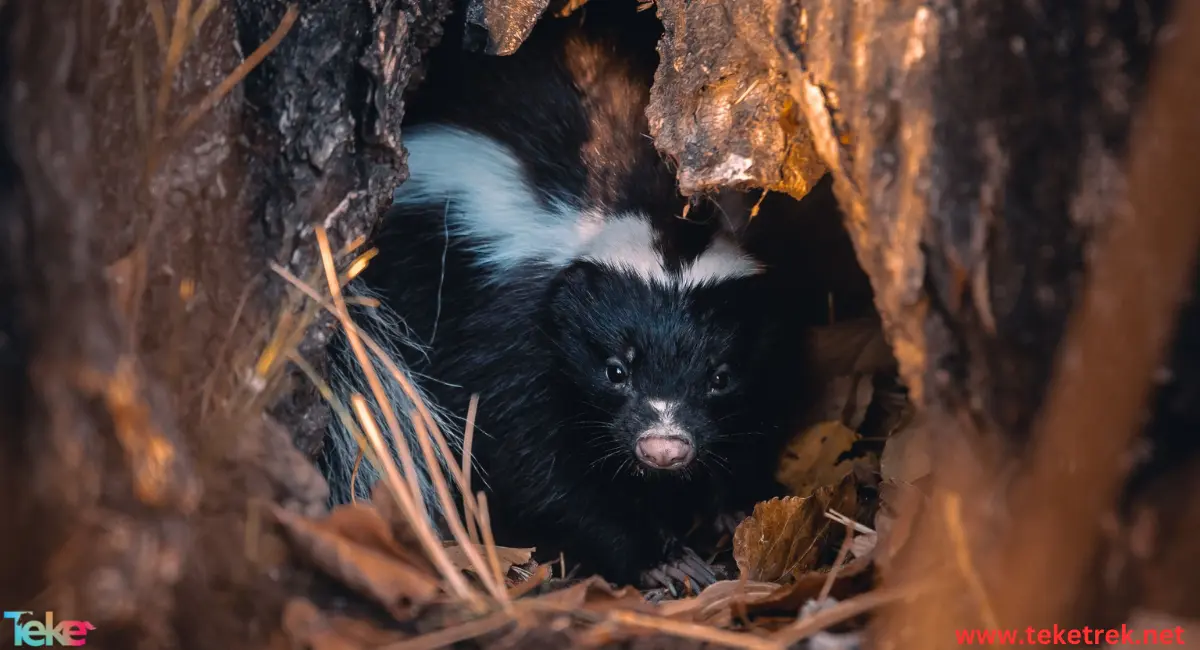The Skunk is an animal skilled in the art of warfare, only attacking its prey after warning with its repulsive weapon represented by its foul odor. It is characterized by its shiny fur. Known to be fearsome, it is excessively self-confident, hunting with indifference, even flaunting its arrogance.
Scientific Name: Conepatus
Let’s learn more about it from teketrek.

Skunk Information:
The Skunk is a type of mammal belonging to the order Carnivora. Its coloration can be black, white, brown, or cream.
It’s also known as Skunk, and among its other names are Striped Skunk and Honey Badger. It varies in size, ranging from 40 to 94 cm, and weighs between 0.50 to 8.2 kg.
The most common fur color is black and white, although there are some species of Skunks that are brown or gray.
All Skunks are striped and have a single thick stripe across their back and tail and white spots. They are also characterized by their short, coarse fur.
The Skunk has a broad, long tail and small eyes. Its ears are located on top of its head, its nose is pointed, and it has short legs with a strong jaw and sharp teeth.
Skunks possess many unique traits and are classified as carnivorous animals.
The Skunk is a fierce and aggressive animal, fearless and powerful. It has a robust body resembling the face of a rabbit or a cat. It has five strong claws, using them to defend itself against enemies.
Skunks are among the most famous animals capable of emitting a strong, odorous spray, a liquid secretion that can be projected up to 4 meters with enough force to reach the predator’s eyes, drenching them in a very foul odor. Particularly when under attack or in danger, they can emit this foul odor, causing predators to immediately retreat. This odor can reach a distance of 20 to 25 feet.
Skunks have strong senses such as smell and hearing, which they use to detect danger and escape.
However, they have very poor eyesight, unable to see objects if they are within 10 feet. In other words, they can only see up to three meters, making them vulnerable to danger.
Skunks live for about 7 or 8 years in the wild, though they can live for 10 years or more.
Despite their chemical weaponry, Skunks are not immune from predators such as horned owls, eagles, mountain lions, wolves, foxes, and large cats.
Skunk Behavior:
There are approximately 11 different species within the Skunk family. Skunks spend their days sleeping in their burrows and become active at night, waking up at dusk to eat and search for prey.
Skunk Habitat:
Skunks are adaptable to living in various environments, from deserts and valleys to mountain forests. They prefer dry places and dwell among rocks, in burrows, and tree hollows. Additionally, they traverse long distances in open territories in search of their diverse diet.
They inhabit hot regions, found in Africa, the Arabian Peninsula, the Levant, Iraq, as well as Iran, India, Turkmenistan, and Pakistan.
Skunks are abundant in the United States, Indonesia, and the Philippines. They thrive in various habitats such as agricultural lands, urban areas, and forests with trees.
They can also survive in cold places, but during the summer, they reside in tree debris, fields filled with grass and vegetables. Moreover, they can live in piles of wood.
Skunk Diet:
Being a nocturnal animal, Skunks spend their days hidden in their burrows and emerge at night in search of food.
Skunks are very voracious eaters, being carnivorous animals that can also consume plants. They are opportunistic feeders, meaning they eat whatever is available, whether meat or plants.
Their diet varies depending on the season. In winter, they prefer fatty foods to keep warm. Skunks feed on insects such as cockroaches, larvae, grasshoppers, worms, and beetles. They also consume rodents, lizards, salamanders, frogs, snakes, birds, and eggs.
It can also eat even poisonous snakes, as it is immune to their venom.. Additionally, they consume berries, roots, leaves, grasses, fungi, nuts, as well as carcasses of birds and rodents, including those killed by cats and other animals.
Skunks are one of the main predators that raid beehives and consume honey. They rely on their thick fur to protect them from bee stings.
Skunk Reproduction:
Skunks are known to mate multiple times, with mating season starting in early April. The gestation period ranges from two months to two months and 10 days, with females giving birth to around 3 to 6 offspring. When Skunks are born, they are unable to see or hear, meaning they are born deaf and blind. Skunks remain solitary except during mating season, and after mating, the male departs.
Benefits and Drawbacks of Skunks:
Among the drawbacks of Skunks is their transmission of numerous parasites and diseases such as rabies. Additionally, they may prey on poultry and domestic eggs. Moreover, they cause digging in gardens, leave holes in lawns, and harm the environment. They can also damage structures by digging underneath them.
On the other hand, one of the benefits of Skunks is their consumption of various harmful insects and rodents, benefiting the environment. Additionally, their soft and dense fur holds high value for humans in various uses. Furthermore, some parts of Skunks are extracted for medicines and remedies to treat diseases, such as rheumatism and fever.
Types of Skunks:
- Striped Skunk: This is the most famous and widespread type of skunk, characterized by a triangular head, long claws on its front legs, and shorter claws on its hind legs, enabling it to dig for food.
- Hog-nosed Skunk: This is the largest species of skunk, reaching up to 82.5 cm in length. It is distinguished by a long white stripe extending to the end of its tail. Additionally, it feeds on cactus, berries, and small reptiles. It inhabits America and Canada.
- Spotted Skunk: This is the only species in its genus that can climb trees. It has short fur on its head and longer fur on the rest of its body, with a white spot on top of its head. It lives in America, Mexico, and Canada, and its diet includes insects, scorpions, rodents, and reptiles.
- Sunda Stink Badger: This shy animal is nocturnal, feeding on bird eggs and worms. It can be found in the forests of Java and Sumatra. It is characterized by its mouth shape, similar to an anteater’s. There are two types of this skunk in Saudi Arabia, both of which are passionate about honey consumption. They fight to access beehives to devour the honey but do not consume the bees.

Frequently Asked Questions
- What is the scent of a skunk?
The scent of a skunk is a strong and foul odor produced by a chemical fluid it secretes from specialized glands when defending itself or feeling threatened. It is believed that this fluid contains sulfur compounds that give it the distinctive foul smell, often described as resembling burnt onion or rotten eggs. This foul odor can travel long distances and linger for a long time, making it an effective means of defense for skunks and warning predators.
- Is a skunk the same as a honey badger?
No, skunks and honey badgers are completely different species of animals, although they may share some characteristics such as the ability to emit a foul odor for self-defense.
- What does the word “skunk” mean?
The word “skunk” is an Arabic name given to a type of mammal, referring to a family of animals known as “skunks,” which includes several species such as the striped skunk and the spotted skunk. The word does not have a specific meaning in Arabic other than being the name of the animal itself.
In conclusion, the skunk remains a cunning and resilient animal with many unknown facts. It plays a specific role in the ecosystem, and interestingly, some countries have begun to rely on its foul odor, using it to manufacture weapons to confront their enemies.





